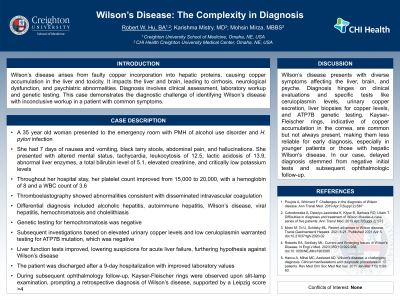Sunday Poster Session
Category: Liver
P1371 - Wilson's Disease: The Complexity in Diagnosis
Sunday, October 27, 2024
3:30 PM - 7:00 PM ET
Location: Exhibit Hall E


Karishma Mistry, MD
CHI Health Creighton University Medical Center
North Wales, PA
Presenting Author(s)
Karishma Mistry, MD1, Robert W. Hu, BA2, Mohsin Mirza, MBBS3
1CHI Health Creighton University Medical Center, Omaha, NE; 2Creighton University School of Medicine, Omaha, NE; 3Creighton University Medical Center, Omaha, NE
Introduction: Wilson’s dx, arises from faulty copper incorporation into hepatic proteins, causing copper accumulation in the liver and toxicity. It impacts the liver and brain, leading to cirrhosis, neurological dysfunction, and psychiatric abnormalities. Diagnosis involves clinical assessment, laboratory workup and genetic testing. This case demonstrates the diagnostic challenge of identifying Wilson’s dx with inconclusive workup in a patient with common symptoms.
Case Description/Methods: 35 y/o woman came to the ER with PMH of alcohol use disorder and H. pylori infection. She had 7 days of N/V, black tarry stools, abdominal pain, and hallucinations. She presented with AMS, tachycardia, leukocytosis, lactic acidosis of 13.9, abnormal liver enzymes, a total bilirubin level of 5.1, elevated creatinine, and critically low potassium levels. Throughout her hospital stay, platelet count improved from 15,000 to 20,000, with hgb levels at 8 and a WBC count of 3.6. TEG showed abnormalities consistent with DIC. Differential diagnosis included alcoholic hepatitis, autoimmune hepatitis, Wilson’s dx, viral hepatitis, hemochromatosis and cholelithiasis. Genetic testing for hemochromatosis was negative. Subsequent investigations based on elevated urinary copper levels and low ceruloplasmin warranted testing for ATP7B mutation, which was negative. LFTs improved, lowering suspicions for acute liver failure, furthering hypothesis against Wilson's dx. The patient was discharged after a 9 day hospitalization with improved laboratory values. During subsequent ophthalmology follow-up, Kayser-Fleischer rings were observed upon slit-lamp examination, prompting a retrospective diagnosis of Wilson’s disease, supported by a Leipzig score >4.
Discussion: Wilson’s disease presents with diverse symptoms affecting the liver, brain, and psyche. Diagnosis hinges on clinical evaluations and specific tests like ceruloplasmin levels, urinary copper excretion, liver biopsies for copper levels, and ATP7B genetic testing. Kayser-Fleischer rings, indicative of copper accumulation in the cornea, are common but not always present, making them less reliable for early diagnosis, especially in younger patients or those with hepatic Wilson's disease. In our case, delayed diagnosis stemmed from negative initial tests and subsequent ophthalmologic follow-up.
Disclosures:
Karishma Mistry, MD1, Robert W. Hu, BA2, Mohsin Mirza, MBBS3. P1371 - Wilson's Disease: The Complexity in Diagnosis, ACG 2024 Annual Scientific Meeting Abstracts. Philadelphia, PA: American College of Gastroenterology.
1CHI Health Creighton University Medical Center, Omaha, NE; 2Creighton University School of Medicine, Omaha, NE; 3Creighton University Medical Center, Omaha, NE
Introduction: Wilson’s dx, arises from faulty copper incorporation into hepatic proteins, causing copper accumulation in the liver and toxicity. It impacts the liver and brain, leading to cirrhosis, neurological dysfunction, and psychiatric abnormalities. Diagnosis involves clinical assessment, laboratory workup and genetic testing. This case demonstrates the diagnostic challenge of identifying Wilson’s dx with inconclusive workup in a patient with common symptoms.
Case Description/Methods: 35 y/o woman came to the ER with PMH of alcohol use disorder and H. pylori infection. She had 7 days of N/V, black tarry stools, abdominal pain, and hallucinations. She presented with AMS, tachycardia, leukocytosis, lactic acidosis of 13.9, abnormal liver enzymes, a total bilirubin level of 5.1, elevated creatinine, and critically low potassium levels. Throughout her hospital stay, platelet count improved from 15,000 to 20,000, with hgb levels at 8 and a WBC count of 3.6. TEG showed abnormalities consistent with DIC. Differential diagnosis included alcoholic hepatitis, autoimmune hepatitis, Wilson’s dx, viral hepatitis, hemochromatosis and cholelithiasis. Genetic testing for hemochromatosis was negative. Subsequent investigations based on elevated urinary copper levels and low ceruloplasmin warranted testing for ATP7B mutation, which was negative. LFTs improved, lowering suspicions for acute liver failure, furthering hypothesis against Wilson's dx. The patient was discharged after a 9 day hospitalization with improved laboratory values. During subsequent ophthalmology follow-up, Kayser-Fleischer rings were observed upon slit-lamp examination, prompting a retrospective diagnosis of Wilson’s disease, supported by a Leipzig score >4.
Discussion: Wilson’s disease presents with diverse symptoms affecting the liver, brain, and psyche. Diagnosis hinges on clinical evaluations and specific tests like ceruloplasmin levels, urinary copper excretion, liver biopsies for copper levels, and ATP7B genetic testing. Kayser-Fleischer rings, indicative of copper accumulation in the cornea, are common but not always present, making them less reliable for early diagnosis, especially in younger patients or those with hepatic Wilson's disease. In our case, delayed diagnosis stemmed from negative initial tests and subsequent ophthalmologic follow-up.
Disclosures:
Karishma Mistry indicated no relevant financial relationships.
Robert Hu indicated no relevant financial relationships.
Mohsin Mirza indicated no relevant financial relationships.
Karishma Mistry, MD1, Robert W. Hu, BA2, Mohsin Mirza, MBBS3. P1371 - Wilson's Disease: The Complexity in Diagnosis, ACG 2024 Annual Scientific Meeting Abstracts. Philadelphia, PA: American College of Gastroenterology.
